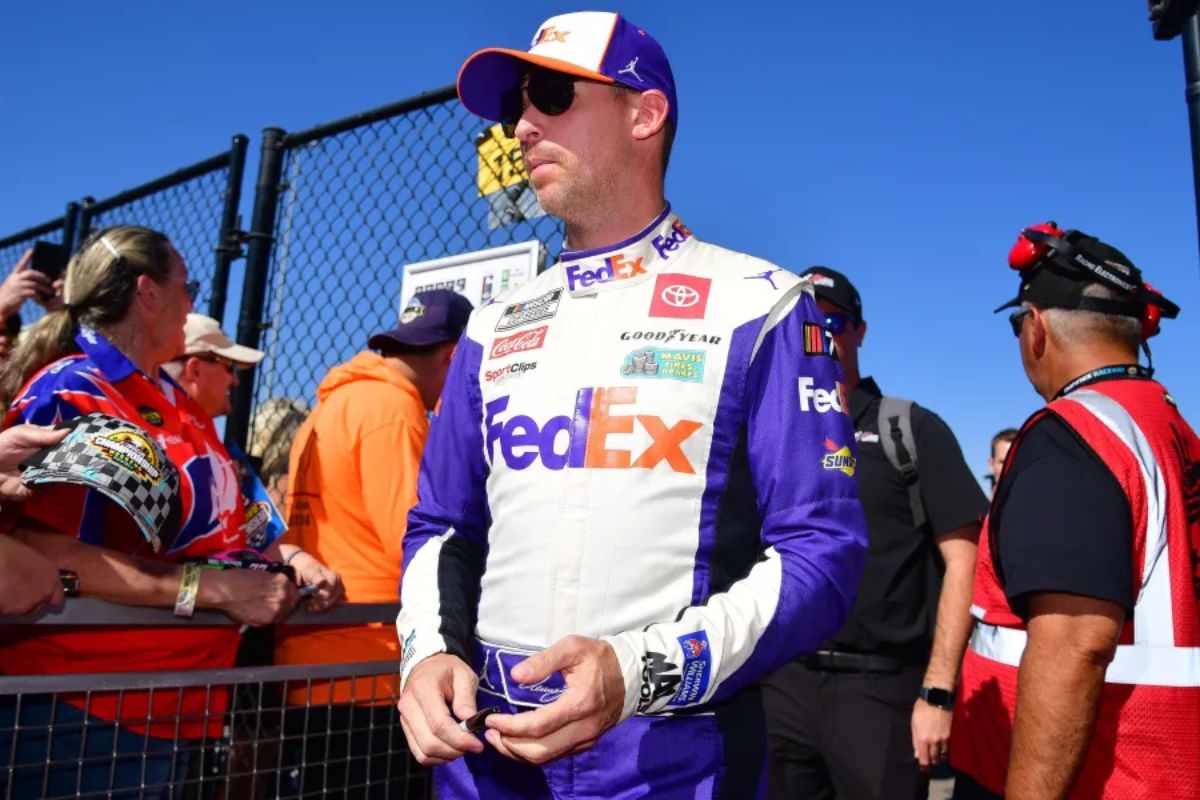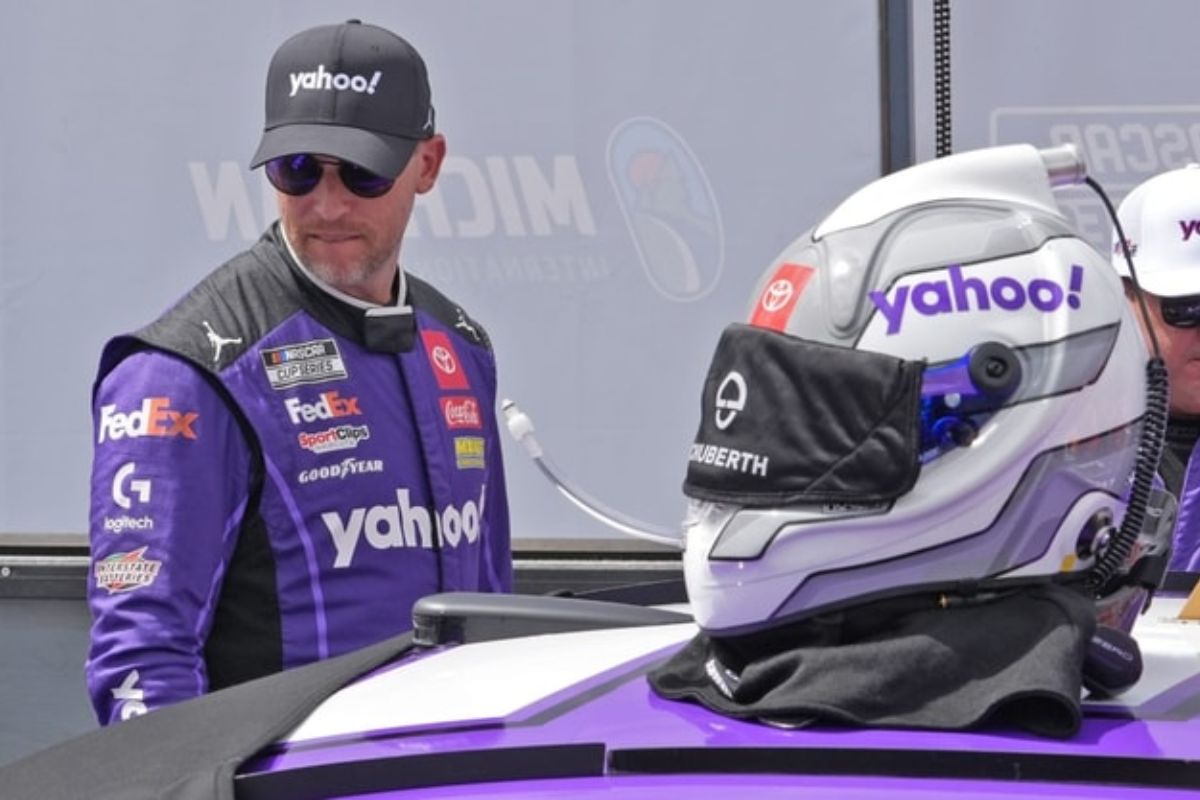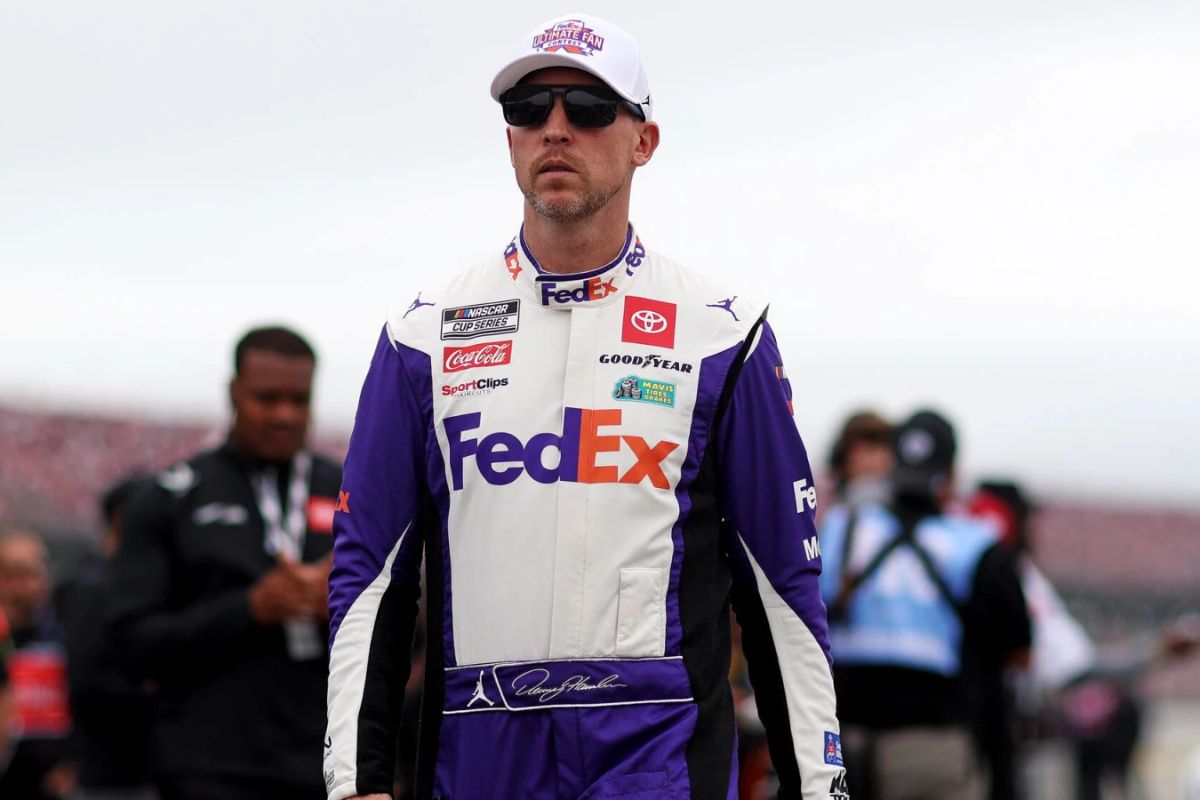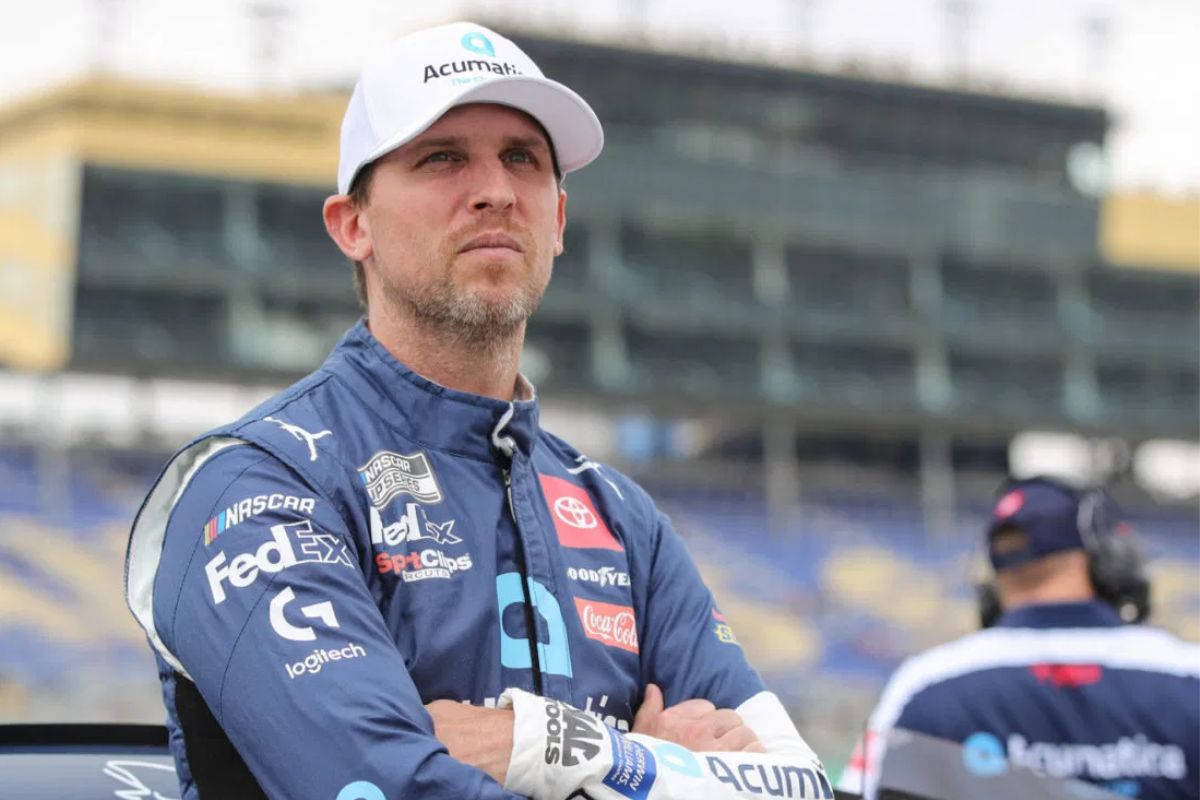Denny Hamlin’s Toyota Sabotage Claim: Denny Hamlin‘s recent allegations of sabotage against Toyota have brought the spotlight back to NASCAR’s ‘Black and White’ rule, which is designed to guarantee equitable competition by imposing stringent penalties for infractions. These claims challenge the integrity of team operations and raise questions about the reliability of equipment within the sport. As NASCAR handles the implications of this situation, the potential for regulatory changes approach that highlights the need for transparency and trust among teams.
Key Highlights
- Denny Hamlin’s sabotage allegations against Toyota raise concerns about competitive integrity within NASCAR.
- NASCAR’s ‘Black and White’ Rule enforces strict penalties for violations to maintain fair competition.
- The claims may prompt a review of existing regulations and enforcement practices by NASCAR.
- Transparency in regulation enforcement is crucial to restoring team trust and addressing accountability issues.
- Hamlin’s situation highlights the evolving challenges teams face amid complex Next Gen vehicle dynamics.
NASCAR Penalty Hits Denny Hamlin Hard
The recent NASCAR penalty imposed on Denny Hamlin has brought considerable turmoil to his racing ambitions, showing the deep impact that regulatory decisions can have on a team’s performance path. Imposed for alleged engine tampering at the Bristol race, the L2 penalty has markedly altered the course of the No. 11 team’s season. Losing 75 points and 10 playoff points, Hamlin’s once-promising championship hopes have been severely compromised.
This penalty diminishes their competitiveness and necessitates a reevaluation of tactics moving forward. The No. 11 team, once a perennial front-runner, must now go through an uphill battle to regain lost ground. The frustration is compounded by the fact that the error originated from TRD, highlighting the complexities of accountability in high-stakes motorsports environments.
While Hamlin has publicly maintained composure, his frank remarks on his podcast reveal the extent of the setback. His insights show how regulatory outcomes can cascade through a season, affecting not just standings, but also team morale and tactical planning.
This incident emphasizes the critical importance of compliance with NASCAR’s rigorous standards, as even seemingly minor infractions can yield considerable consequences.
As Hamlin and his team regroup, the lessons from this penalty will likely resonate beyond the current season, shaping their approach to future races. NASCAR’s stringent regulatory framework serves as a reminder that in racing, precision, and diligence are paramount, with each decision carrying potential consequences for championship aspirations.
The Engine Incident at TRD
Numerous complexities surround the engine incident at Toyota Racing Development (TRD), where the No. 11 team’s race-winning engine underwent unauthorized modifications. Essential to understanding this situation is the life cycle of a racing engine, which necessitates meticulous reassessment after each use. While all teams adhere to NASCAR’s stringent inspection protocols, the No. 11 engine’s post-race handling raised considerable questions.
Upon returning to TRD, the engine, identifiable by its red seal, was improperly disassembled and repaired before being returned to the team. Such actions contravene NASCAR regulations, which are designed to maintain fairness and integrity within the sport. Denny Hamlin’s assertion that he competed with the same engine at Darlington adds complexity to the narrative.
Hamlin’s Frustration with the Penalty
Amidst the fallout from the engine incident, Denny Hamlin‘s frustration with the ensuing penalty has become increasingly evident. The veteran driver articulated his discontent on the Actions Detrimental Podcast, emphasizing the procedural mishaps that led to the penalty. Specifically, Hamlin noted that the engine, rather than being returned to NASCAR after its cycle, was sent to Costa Mesa for refurbishment. He suggested that Toyota’s revelation of the severed seals raised questions about the integrity of the process, implying negligence or oversight.
“Instead of it going back to NASCAR because it’s done with its engine cycle, it got sent to Costa Mesa. They cut the seals off and rebuilt the engine, and immediately Toyota’s like, they more than likely saw these red seals sitting on the ground or someone’s desk, and they’re like, Wait a minute, why are these here? Who cut these off? That’s what should’ve been said anyway.” – (hamlin)
Hamlin’s acknowledgment of the penalty’s inevitability highlights the rigid nature of NASCAR’s rules. He recognized the “black and white” stipulation within the rulebook that mandates severe consequences for engines not returned for inspection. The L2 penalty he faced is a clear reflection of the stringent enforcement that NASCAR applies, which leaves little room for interpretation or leniency.
“We’ve got something in our rule book that is pretty black and white. If the engine doesn’t go back for inspection or whatever, it’s an L2 penalty, and here’s what it is. They told me and I found out on Thursday and certainly was not a good day for me, nor has the last three straight days; it’s been bad.” – (hamlin)
NEWS: Denny Hamlin gets crushing NASCAR L2 penalty for an engine rules violation committed by Toyota. Hamlin loses 75 points, 10 playoff points, crew chief Chris Gabehart fined $100k.
TRD tore down and rebuilt one of Hamlin's winning engines before it was inspected by NASCAR,…
— Jeff Gluck (@jeff_gluck) August 22, 2024
His disappointment grew noticeable as he recounted the moment he learned of the penalty, describing it as an overwhelmingly negative experience that lingered for days.
The combination of procedural errors and the harsh penalty has positioned Hamlin in a challenging situation that impacts his competitive standing and morale. His frank reflections reveal an underlying frustration with the penalty itself and with the broader implications of regulatory practices within NASCAR.
Hamlin’s Daytona Disappointment
Disappointment loomed large for Denny Hamlin during the Coke Zero 400 at Daytona, where he struggled to translate his impressive track record into a competitive performance. Despite entering the race with the distinction of having the best active record at Daytona—boasting three victories—Hamlin’s week was tainted by a hefty penalty that hindered his preparations and affected his car’s setup.
The race itself was turbulent, and Hamlin found himself embroiled in a notable incident sparked by Corey LaJoie during Stage 2. This collision showed the unpredictable nature of restrictor plate racing at Daytona, where positioning and timing are critical. Unfortunately for Hamlin, being caught in the wrong place at the wrong time has become a recurring theme in his recent outings at this storied track.
The Next-Gen car, while promising in many respects, has not yielded the desired results for Hamlin, especially in the last six Daytona races. His inability to secure a top-10 finish during this stretch highlights a troubling trend, contrasting sharply with his previous successes.
Each race has further compounded the disappointment, as Hamlin’s legacy at Daytona now feels overshadowed by a series of unfortunate events. As the season progresses, the challenge for Hamlin will be to recalibrate his approach and restore confidence in his Daytona performances.
Hamlin Reflects on Daytona Struggles
The challenges Denny Hamlin faced at Daytona have prompted a reflective mindset, as he grapples with the harsh realities of racing in the Next Gen era. His experiences reveal a pattern of frustration that stems from the unpredictable dynamics at superspeedways. In his frank assessment, Hamlin acknowledges a shift in mindset, accepting that a good run may elude him more often than not.
“I just need to be okay with it; I just need to ride in line here, and if I get caught up in a wreck, I get caught up in a wreck and not be surprised, right? So just in the Next-Gen era, my finish rate at superspeedways has not been good at all, and nothing I’ve caused. It’s just somebody else making silly moves, and we got caught up in it.” – (hamlin)
- Acceptance of Reality: Hamlin recognizes the inevitability of being caught in wrecks due to the reckless tactics of other drivers.
- Finish Rate Concerns: He notes a troubling decline in his finish rate at superspeedways, highlighting the challenges posed by the new car configurations.
- Mindset Adjustment: The necessity to adopt a more resigned approach shows a coping mechanism in the face of adversity, rather than a proactive strategy.
- Team Morale Impact: The cumulative effect of these struggles has dampened the spirit within the No. 11 team, necessitating a focus shift as they approach the final regular-season race.
As they head to Darlington, regaining focus and resilience will be essential for Hamlin and his team as they prepare for the impending playoff battles. Only by addressing these challenges can they hope to turn the tide in their favor.
News in Brief: Denny Hamlin’s Toyota Sabotage Claim
The allegations of sabotage raised by Denny Hamlin regarding Toyota have important implications for NASCAR’s regulatory framework, particularly the ‘Black and White’ rule. These developments highlight the necessity for transparent enforcement of rules to foster trust among teams and maintain competitive integrity within the sport.
As NASCAR deliberates on the credibility of these claims, potential revisions in regulations may emerge to address ongoing challenges, thereby ensuring a fairer competitive environment for all participants.
ALSO READ: Denny Hamlin’s 100k Dollar Blunder Intensifies Clash Between Michael Jordan and Rick Hendrick’s Team




